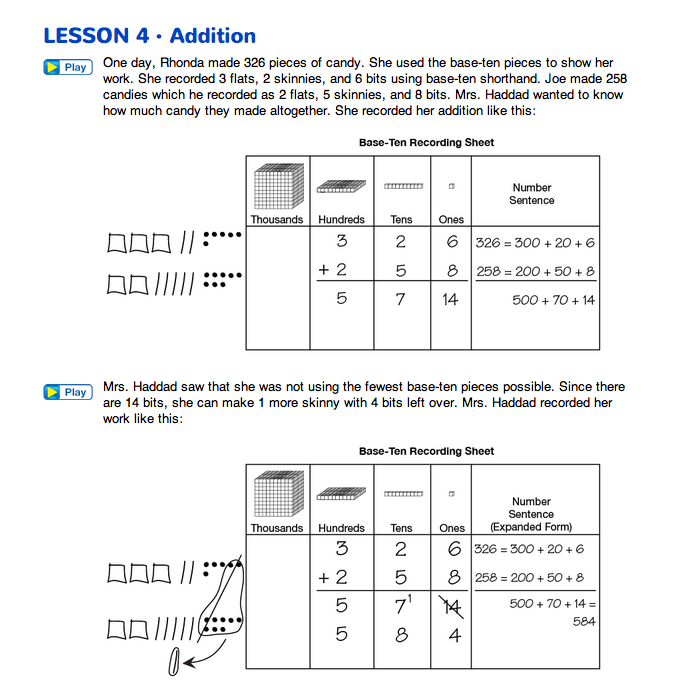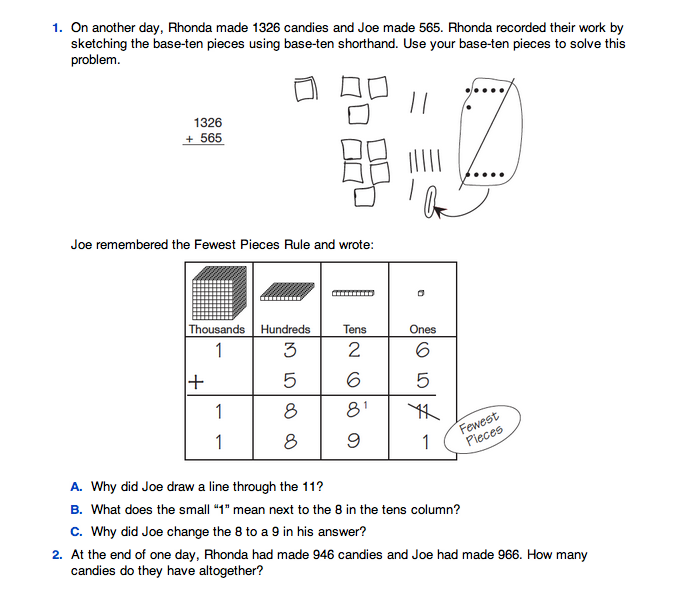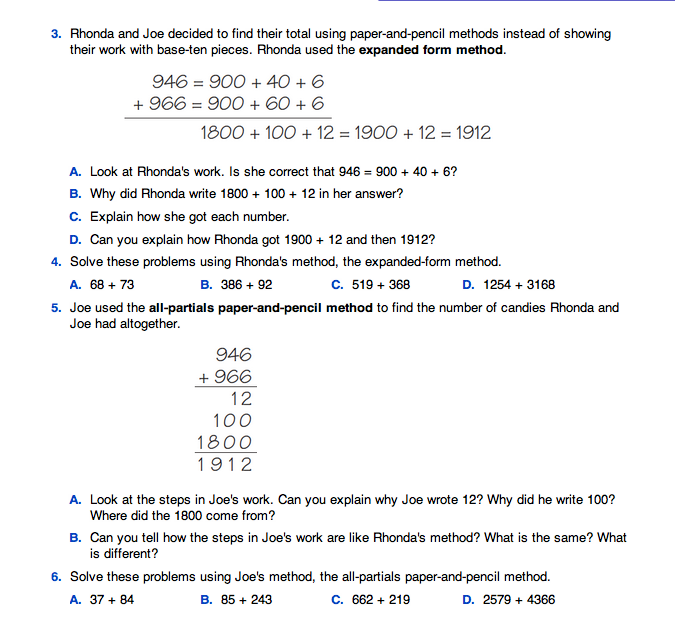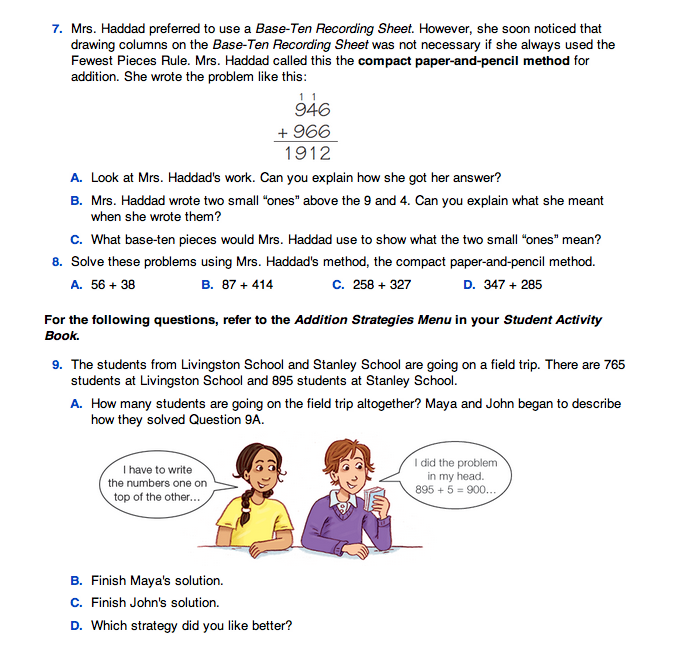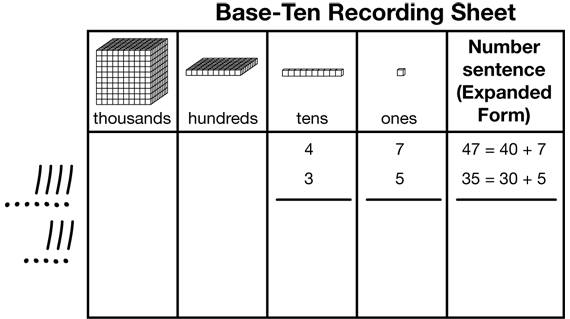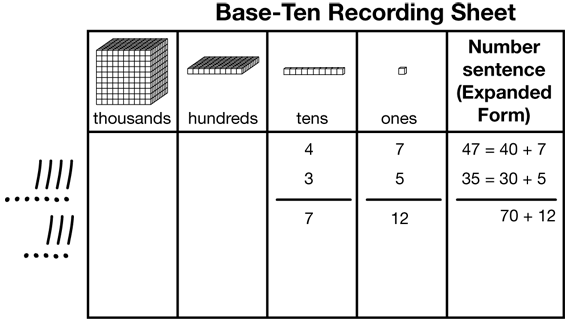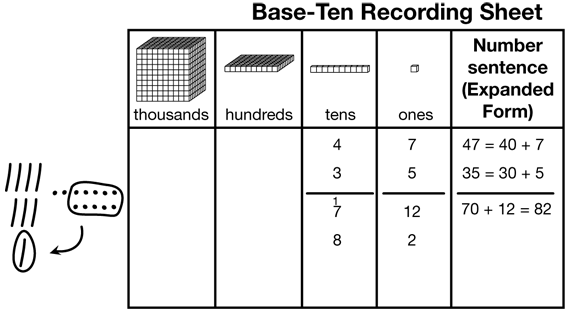Addition
Est. Class Sessions: 2–3Developing the Lesson
Part 2. Adding with Base-Ten Pieces and Paper-and-Pencil Methods
Show Problems and Compare Representations. In the following activity, students model addition problems using base-ten pieces and the Base-Ten Recording Sheet. Even students who are proficient with an algorithm can benefit from having the concepts of regrouping in addition reinforced with the base-ten pieces.
Display and pose the following problem:
Give 4 copies of the Base-Ten Recording Sheet Master to each student and ask student pairs to work together to show how to solve this problem using base-ten pieces or shorthand. Use Figure 3 to help students get started and to provide assistance with the recording where needed. Give students a few minutes to find a solution to the problem using whatever strategy they choose.
Ask a pair to share their solution strategy using a display of the Base-Ten Recording Sheet Master. Students should show the numbers using both base-ten shorthand and a number sentence. Once the numbers are recorded, students should show the class how they recorded and found the sum. See Figure 4 for one possible strategy.
Ask students to compare the totals in the tens and ones columns with the totals in the number sentence column.
Ask:
Ask a student to show how to use the base-ten pieces to solve the problem.
Figure 5 shows one way of recording the trades using base-ten shorthand and the recording sheet. Other methods are possible. Ask a student to record his or her trades and show them to the class.
Ask the class to consider the trades using prompts similar to the following:
Emphasize that the notation for showing the trade with the base-ten shorthand and the notation for showing the trade with the numbers both refer to the exact same action, i.e., trading the 10 bits for one skinny and trading 10 ones for one ten.
Ask pairs to use a Base-Ten Recording Sheet to solve the following problem:
Give students a few minutes to work on a solution and then ask them to open their Student Guides to the Addition pages. Ask students to compare their solutions with Rhonda's solution and Mrs. Haddad's work.
Ask:
Ask students to work with a partner and read and complete Question 1 of the Addition pages. This question asks students to solve another problem using base-ten pieces and reminds students of the Fewest Pieces Rule. In the class discussion of Questions 1A–1C, be sure students connect the trades represented in the base-ten shorthand to the trades shown by Joe in the recording sheet.
Ask:
Have students solve another problem by asking them to solve Question 2 using any strategy they choose.
Use Paper-and-Pencil Methods. Once students have had a chance to solve the problem ask them to look at Rhonda's strategy, expanded form, in Question 3 and to answer Questions 3A–3D. These questions ask students to look at her strategy closely and explain what each part of her solution represents in the problem. Base-ten pieces or shorthand might help some students visualize what is happening in the expanded form method.
Ask:
Ask students to try this expanded form method by solving the addition problems in Question 4.
For example:

Choose a student to record his or her solution to one of the problems in Question 4 on chart paper so the expanded form can be added to the class collection of addition strategies.
Referring to Question 5, tell students that Joe decided to solve 946 + 966 using the all-partials method. Ask students to use Questions 5A and 5B to analyze Joe's solution. Once these questions are reviewed and discussed, ask students to try the all-partials method when they solve the addition problems in Question 6.
Ask:
Choose a student to record his or her solution to one of the problems in Question 6 on chart paper so that the all-partials method can be added to the class collection of addition strategies.
Referring to Question 7, tell students that Mrs. Haddad solved 946 + 966 using yet another method, called the compact method. Ask students to use Questions 7A–7C to analyze Mrs. Haddad's solution. Once these questions are reviewed and discussed, ask students to try the compact method when they solve the addition problems in Question 8. Record the solution for one of the problems in Question 8 on the chart paper so it can be added to the class collection of addition strategies.














